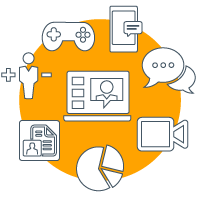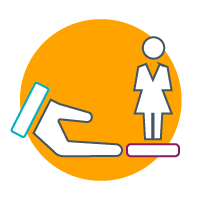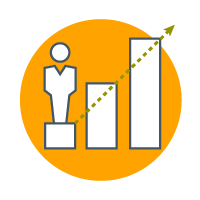The traditional approach to learning journeys is no longer cutting it. Learning journeys have traditionally been designed to solve a leadership challenge over the course of a predefined time—6 or 12 months, for example. But at DDI, we know that learning journeys must be comprehensive and continuous over the course of a career and flexibly fit ever-changing leadership challenges. In this blog, I'll discuss why it's important for organizations to evolve their approach to learning journeys and shift away from "one and done" leadership programs. I'll also provide best practices for how to create learning journeys to support modern leaders in a fast-paced business world.
What Is a Learning Journey?
Traditionally, a learning journey has been defined as a unique plan that is founded on the challenges facing your organization and the most critical skills leaders need to achieve business success. It’s always been defined as an intentional, linear path to meet a business, leadership, or learning need. And it's sequential.
A learning journey has typically been designed for groups, cohorts, or communities of leaders. It takes place over time and incorporates a strategic mix of learning methods intended to meet the needs of today’s learner. It often begins with a review of relevant organizational and assessment data, the business drivers, and the target audience’s development gaps. L&D teams can use all of this information as the starting point for designing the learning journey.
While many elements of the traditional definition of a learning journey still ring true, learning journeys shouldn’t be completely linear. Learning journeys should still be designed to help a group of leaders solve broad organizational challenges. But it’s time to empower individual leaders within these journeys to take a unique pathway, outside of or in addition to the linear journey, to meet their personal learning or business needs.
Learning journeys must become more flexible and impactful as continuous, personalized journeys that follow the careers of the learners. And they shouldn’t track one path for all leaders. Learning journeys must be continuously analyzed and molded to fit the unique needs of each leader as their careers grow and change, always considering both the skills they uniquely need to grow and their preferred learning styles.
While journeys should be personalized to each leader’s unique learning needs, they must still be grounded in the context of the organization and highly connected to the overall goals of the business.
Reasons to Invest in Learning Journeys
It’s beneficial to invest in learning journeys because this approach to development ensures tight alignment with your organization’s strategies. Your leaders develop skills that are linked to your business needs, which has bottom-line implications.
According to DDI’s Global Leadership Forecast 2021 research, companies that use blended learning journeys compared to those that do not are 8 times more likely to have a highly-rated leadership development program, 5.8 times more likely to have a strong supply of leaders for critical roles, and 2.3 times more likely to be financially successful.
Additionally, implementing effective learning journeys can help companies engage and retain talent. Recent research from McKinsey shows that the top reason employees quit over the last year was because they lacked career development and advancement opportunities. If you’re not developing your people, they’re likely to head for the door. But not just any development will do. Make sure you’re following best practices for how to create a learning journey, which I’ll discuss more below.
Finally, effective learning journeys benefit leaders themselves. Simply put, when done right, learning journeys create better and more skilled leaders. And if you use blended learning strategies with group-based development or collaborative peer learning, leaders get the chance to network and build stronger relationships.
5 Best Practices for Creating Effective Learning Journeys
Now let’s jump into our five best practices for creating effective learning journeys. Learn how to ensure your learning approach is continuous, includes multiple modalities, has senior leader support, is personalized, and is data driven—and why it matters that you get these best practices right.

1. Effective Learning Journeys Are Continuous
Recall the traditional way of thinking about a learning journey: a waterfall of activities that’s typically “one and done.” It’s linear and pre-planned from the start. But what we know after years of developing leaders is that the most effective learning experiences are continuous as the learner gains new skills and discovers new areas they need to develop.
Learning journeys today evolve and adapt without a short-term end date. There may be an intentional starting approach, for example, a journey to upskill leaders in leading their teams in a hybrid workplace. The bulk of that learning may occur over a specific time frame, but there are also interactive self-guided tools built in to sustain learning long after.
In addition, a journey like this includes flexibility to start and stop depending on what a leader may have going on, and the capability to choose a learning style that fits their needs. Learning journeys like this are continuous to address all the moments of need across a leader’s career—both expected and unexpected moments. For example, learning journeys support a leader in their transition from an operational leader to a strategic senior-level role. But when there’s an unexpected major shift in the business like a merger, their journey helps them learn the new core skills to succeed in their company’s new landscape.
This next best practice for how to create a learning journey covers why it’s so important for leaders to choose the modality that fits their learning style.

2. Effective Learning Journeys Are Blended
We know from decades of surveying and talking with leaders that they prefer learning using a blend of modalities. This includes a mix of classroom learning with self-directed options and development assignments. We say that the magic is truly in the mix of modalities that work best for your leaders.
Plus, one thing we know as experts in learning and development is that people learn better when there’s variety in their learning journey. This variety keeps leaders’ engagement high and helps them make continuous new connections to concepts.
So what does variety of learning modalities mean? It means leaders have options to choose between virtual, in-person, or self-paced learning courses. Organizations can also offer microcourses, self-insight tools and assessments, games, simulations, and other digital tools to help leaders practice new skills on demand.
Offering a variety of digital and in-person learning experiences helps L&D professionals meet leaders in their moment of need. Meeting leaders in the moment means providing content and tools on a specific topic, challenge, or skill they need.
But sometimes digital or self-directed learning options get a bad rap because the right accountability structures aren’t in place for leaders. “Build it and they will come” is never an effective approach. However, there are ways to successfully implement self-directed leadership development. The key is that L&D professionals create a structure that makes learning happen better. For example, giving leaders time to process what they’re learning on their own, and then coming back together in peer learning groups to discuss what they learned. This is just one way to ensure self-directed learning sticks.

3. Effective Learning Journeys Are Supported by Senior Leaders
When senior leaders understand the value of your program, they can also communicate and champion it to employees, making learners more likely to participate.
Having senior leaders as stakeholders who back your program can make all the difference. They can help ensure that your program is connected to your business strategy. And the more buy-in you have from the top, the more your program will be socialized within the organization. When it’s time for investment decisions about your program, senior leaders are more likely to feel ownership for current success. This can lead to more budget coming your way for expansion and improvements.
It’s also important to consider support where it matters most for your learners: their own managers should support their learning journey and development. This is a great article that offers strategies for securing manager support for leadership development.

4. Effective Learning Journeys Are Personalized
Why does personalization make a difference for learners? When development is personalized, it feels relevant. Personalized development is relevant because it's also anchored on your business context. Leaders want to connect how their development will drive success for themselves as well as for the organization.
But personalizing a learning journey must be grounded in self-insight and data. Leadership assessments can provide leaders with data on their strengths and gaps. This data can be used to influence and bring focus to a leader’s learning journey—both at the individual and group level.
When it comes to personalized learning journeys, make sure that if it’s not completely evident to your leaders that it is personalized, you directly communicate it as such. I’ve seen leaders respond well to a message like, "This is personalized for you, and here's how we did that." Communicating that your programs are personalized can help with adoption. It can also create excitement for leaders to get started on development that was built especially for them!

5. Effective Learning Journeys Are Data Driven
Being data driven allows learning journeys to be more flexible and adaptable, which is important in our ever-changing business landscape. Using data can help you pivot quickly and shift a learning journey to respond to major organizational changes. For example, self-assessment data from a company’s leaders who have recently completed a merger can show skill gaps in a newly formed group of leaders.
It’s also important to collect data at different points of your program to help you understand what’s working and what’s not. Knowing what’s effective can help you adjust the learning journey along the way according to the changing goals and needs of the learner—and your organization.
For example, measurement tools can be used to evaluate the program’s impact on your leader’s reactions, learning, and behavior change, and on organization-level metrics. Having data readily available on the impact of your leadership programs can help you highlight their success. And being able to prove the worth of your program can be crucial to sustaining your program (and your job as an L&D professional!) during disruptive times when budgets are under more scrutiny.
But more than that, being able to connect organization-level metrics to your leadership program metrics can help you see how the quality of leadership truly impacts company performance.
Implementing Effective Learning Journeys
Even the most thought-out learning journey can flop if it’s not implemented in the right way. So what are some best practices for implementing a learning journey?
We’ve already discussed some keys to implementation in this blog. It’s important to measure and track the results of your learning journey, including gathering data along the way. It’s also important to gain stakeholder engagement to help you influence, support, and accelerate your learning program.
Additionally, focus on creating a communication strategy to get everyone excited about their learning journey. This includes thoughtfully considering how you’ll kick off your learning program.
Learning Journeys Done Well Create Behavior Change and Adapt to Change
What a learning journey does best is create behavior change by reinforcing a blend of formal, self-guided, and peer-interactive development activities. Learning must be continuous to make progress toward mastery of competency areas.
But the best learning journeys are also flexible and open to change. After all, as the Prime Minister of Canada, Justin Trudeau, said “The pace of change has never been this fast, yet it will never be this slow again.”
Learning and development professionals have certainly gotten used to change over the past several years. Let’s remain adaptable to keep learning journeys relevant for leaders with constantly changing roles and challenges.
Learn more about how to create a learning journey for your leaders.
Alex Smith is a consulting manager within DDI’s US Operations. He leads a team of consultants and is the engagement manager for several of DDI’s largest client partnerships across the globe.
Topics covered in this blog

